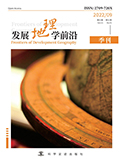

本文以中国超大特大城市为研究单元, 从低碳经济、低碳开发、低碳生活、低碳环境、低碳能耗5个维度选择18个指标, 构建了低碳发展评价体系, 并结合数据包络分析, 对我国超大特大城市低碳发展水平进行多维度综合测度评价。研究结果表明: (1) 我国16个超大特大城市2005年、2010年、2015年平均综合得分分别为0. 0892、0. 0854、0. 863, 低碳发展水平总体呈现出先减小后回升的趋势; (2) 在空间上, 东部城市低碳发展水平总体较高, 但其内部差异较大, 京津冀地区发展不均衡, 北京发展水平较高、而天津发展水平较低。西部地区发展指数总体较低, 重庆、成都、西安得分均为低水平和较低水平; (3) 2005—2015年低碳经济发展平稳提升, 其中东部地区发展水平明显提升, 低碳开发发展下降, 低碳生活呈明显下降趋势, 低碳环境发展有所改善, 低碳能耗的发展基本稳定, 但格局略有变化; (4) 2005—2015年全国低碳发展综合绩效整体水平不高, 发挥到最优水平的75. 3%, 存在投入-产出效率不高的问题。低碳发展纯技术效率仅发挥到最优水平的88. 3%, 具有较大发展潜力。低碳发展规模效率发挥到最优水平的90%, 存在提升空间。
Taking China's megacities as the research unit, this paper selected 18 indexes from five dimensions: low-carbon economy, low-carbon development, low-carbon life, low-carbon environment and low-carbon energy consumption, and constructed a low-carbon development evaluation system. Combined with data envelopment analysis, a multi-dimensional and comprehensive measurement evaluation of the low-carbon development level of China's megacities was also conducted. The results showed that: (1) The average comprehensive scores of 16 Chinese megacities in 2005, 2010 and 2015 were 0. 0892, 0. 0854 and 0. 863, respectively. The low carbon development level showed a trend of first decreasing and then rising. (2) Spatially, the low-carbon development level of eastern cities was generally high, but the internal differences were large, and the development of the Beijing-Tianjin-Hebei region was uneven, with Beijing having a higher level of development and Tianjin having a lower level of development. The development index of the western region was generally low, and the scores of Chongqing, Chengdu and Xi'an were all at low and lower levels. (3) From 2005 to 2015, the development of low-carbon economy increased steadily, of which the development level of the eastern region was significantly improved. The level of low-carbon development had declined. The level of low-carbon living was showing a significant downward trend. The development of a low-carbon environment had improved. The development of low-carbon energy consumption was basically stable, but the pattern had changed slightly. (4) From 2005 to 2015, the overall level of the comprehensive performance of national low-carbon development was not high, which reached 75. 3% of the optimal level, and there was a problem of low input-output efficiency. The pure technical efficiency of low-carbon development had only reached 88. 3% of the optimal level, which had great development potential. The scale efficiency of low-carbon development had reached 90% of the optimal level, and there was room for improvement.